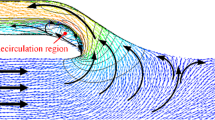Abstract
In the process of performance prediction of waterjet system, the flow loss of inlet duct is usually reckoned by the rule of thumb. But its value is often overestimated to some extent, resulting in error of prediction accuracy. This paper introduces a new method to determine the flow loss by means of computational fluid dynamic (CFD). Firstly, the fluid field around waterjet system is simulated by solving the Reynolds Averaged Navier-Stokes (RANS) equations using commercial CFD code Fluent. Then an additional User-Defined Scalar (UDS) equation is embedded into Fluent to get the virtual dividing surface between the internal flow ingested into the inlet duct and the external flow beneath the hull, which is named as streamtube. By virtual of the streamtube the flow loss can be calculated according to the difference of total pressure between the duct outlet and the capture area ahead of the intake. The results from CFD calculation show that the flow loss coefficient of a typical flush-type inlet duct is varying from 0.05 to 0.12 at different operation conditions, being obviously less than the value of 0.2–0.3 from empirical rules. With the results of this paper the prediction accuracy on propulsive performance of the waterjet system can be improved further.
Similar content being viewed by others
References
Allision J. Marine waterjet propulsion [J]. SNAME Transactions, 1993, 101: 275–335.
Jin P Z. Marine waterjet propulsion [M]. Beijing: National Defense Industry Press, 1988 (in Chinese).
Bulten N, Verbeek R. CFD simulation of the flow through a waterjet installation [C]//Proceedings of the 7th Symposium on High Speed Marine Vehicles. London: RINA, 2005: 149–157.
Bulten N, van Esch B. Review of thrust prediction method based on momentum balance for ducted propellers and waterjets [C]// Proceedings of FEDSM 2005. Houston: ASME, 2005: 1244–1252.
Bulten N. Numerical analysis of a waterjet propulsion system [D]. Eindhoven, Netherlands: Eindhoven University of Technology, 2006.
Terwisga Van. Report of the specialist committee on waterjets [C]// Proceedings of the 23rd International Towing Tank Conference. Venice: International Towing Tank Committee, 2002: 387–415.
Terwisga Van. Report of the specialist committee on waterjets [C]// Proceedings of the 24th International Towing Tank Conference. Edinburgh: International Towing Tank Committee, 2005: 471–508.
Ding J M. Thrust computation of waterjet propulsion system based on momentum flux method and CFD code [J]. Journal of Naval University of Engineering, 2008, 20(2): 91–95 (in Chinese).
Seil G J. The effect of the shaft, shaft rotation and scale on the flow in waterjet inlets [C]// Proceedings of the International Conference on Waterjet Propulsion III. Gothenburg, Sweden: RINA, 2001: 1–12.
Author information
Authors and Affiliations
Corresponding author
Rights and permissions
About this article
Cite this article
Ding, Jm., Wang, Ys. Research on flow loss of inlet duct of marine waterjets. J. Shanghai Jiaotong Univ. (Sci.) 15, 158–162 (2010). https://doi.org/10.1007/s12204-010-8130-x
Received:
Published:
Issue Date:
DOI: https://doi.org/10.1007/s12204-010-8130-x




